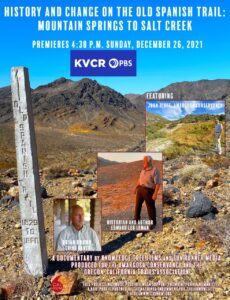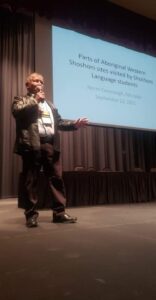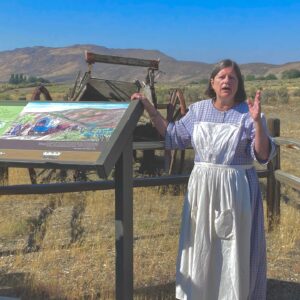The Oregon-California Trails Association (OCTA) provided the following highlights for the Oregon and California NHTs during the 2021 calendar year:
Education, Interpretation and Cultural Expression

Flyer for the OCTA documentary premiering on KVCR (San Bernardino PBS) on December 26. Courtesy OCTA.
- OCTA partnered with the Amargosa Conservancy to win a California Humanities Council grant and the end result is a 25-minute documentary about the trail near Death Valley. The first broadcast will be on KVCR, the PBS station in San Bernardino, on December 26. They will continue to broadcast the show over the next five years. The documentary features the history of the Old Spanish Trail and its later use by Mormons and 49ers as a wagon road. It also features the work of the Amargosa Conservancy to preserve this area, including a discussion of climate change and its effects on the trail and its setting and a special focus on the tribes that originally developed the trail corridors.
- OCTA won a grant from the South Dakota Humanities Council to create a PBS documentary about Hansen Wheel and Wagon, a company in South Dakota that restores historic wagons and stagecoaches and also creates new wagons and stagecoaches. They work with well-known corporations and Hollywood movies and TV shows to provide historically accurate animal-drawn vehicles. This documentary will be completed in late 2021 and will debut in early 2022.
- OCTA won a grant from the Missouri Humanities Council to create a short documentary about the Butterfield Overland Stage Route through Wilson’s Creek National Battlefield near Republic, Missouri and the trail’s role in the second major battle of the Civil War. It is expected to debut early in 2022.
- Utah Crossroads is working with Ensign Properties in Lakepoint, Utah, to turn a 3.5-acre area into a pioneer park in the middle of a housing development. It is a known pioneer-era campsite. A trail swale and portions of the E.T. Canal (starting in 1850) run through the park. Ensign Properties will turn the site over to the Lakepoint Cemeteries and Parks Division. The land deed will feature language that includes OCTA Utah in any site planning and improvements. The NPS has expressed interest in future interpretative site development. Local historical groups are also interested in using the site to promote local history.
- The Crossroads Chapter evaluated several kiosks that it built and maintains in Davis County, Utah. Two of them, one in Farmington and another in Bountiful, Utah, require refreshing and repair. Both need new signage and roof repairs. We plan to rejuvenate them in Spring 2022.
- On August 28, 2021, the Utah Crossroads Chapter placed a new Rail Post Marker where the Central Overland Trail crosses the Utah-Nevada border. It was a 360-mile round trip.
- The National Park Service, National Trails office (NTIR) completed a signing and interpretation project in partnership with the Mid America Regional Council (MARC) and the City of Independence, MO. MARC developed a new recreation trail close to the California, Oregon and Santa Fe National Historic Trails (NHTs) alignments, and which connects to other recreation trails in Independence, MO. NTIR provided financial and technical support toward signing this newly developed ADA compliant trail and trailhead and created NHT specific orientation and interpretation panels. This trail project was the first to be implemented from the Kansas City Development Concepts Plan, completed in 2018 by NTIR in partnership with MARC, the design firm VIERO, and the Oregon California Trails Association (OCTA).

Carleton Watkins, “City of Portland, Oregon” (1867). Oregon Historical Society.
- When dealing with events as significant as overland migration along the Oregon Trail, it is easy to focus on the broad outlines without delving deeper into the lived experiences of historical actors. In October 2021, the National Park Service, National Trails office (NTIR) received a report titled “First Year in Oregon, 1840-1869: A Narrative History”which was an attempt to explore what exactly awaited the thousands of emigrants who reached Oregon’s Willamette Valley. Where did new arrivals stay? What did they eat? Did Oregon meet their expectations? The full report, completed by a contractor, spans over 200 pages and addresses these questions and more. Notably, the study also highlights the effects of Oregon’s settlement on non-white communities, such as the Kalapuyan and Chinookan people eventually forced by the US government to leave the Willamette Valley.A 2-page summary of the report is posted on the Trail’s website, offering a quick look at the study’s findings. NTIR also received a database of quotes used in writing the report, as well as a thorough list of relevant images. In this way, the contractor’s deliverables will have a sort of “afterlife” as a helpful one-stop shop for future NTIR projects dealing with the early emigrant experience in the Willamette Valley.
Conserving Trail Lands and Boosting Climate Resilience
- The Idaho State Historical Society reopened an updated and refurbished Rock Creek Station/Stricker Ranch Park near Twin Falls. This location was a camping spot on the Oregon Trail and one of the first stores to provide goods to emigrants, as well as a later stage station and farm.
- The BLM put a roof on the Canyon Creek stage station and the Idaho Chapter assisted with a cleanup of the site. This location was a major camping spot on the Oregon Trail and later a stage station.
- The Nebraska Chapter successfully partnered on a lawsuit to stop the R-Project near the Sutherland rest stop on I-80. The site contains ruts from the Oregon-California Trail and is well-interpreted and highly visited. The powerline was to be built on top of the site. The case was decided in a Denver federal court.
- The Northwest Chapter continues to fight the B2H powerline project in eastern Oregon in federal court. Chapter members/OCTA staff and officers will testify in January.
- Last fall, the CA/NV Chapter did a metal detecting survey to confirm routes into Lassen’s Rancho Bosquejo. Some 9,000 49ers (1/3 of the 1849 Gold Rush) used the route, as others were depleted of grass by the time final emigrants arrived. The Lassen route was longer but provided grass and a lower/less dangerous entrance into California.
Collaboration and Engagement
- OCTA and our Northwest Chapter worked with the National Park Service to conduct a trail survey at Westminster Woods in the Blue Mountains of Oregon. The project was funded via a cooperative agreement with NPS.
- OCTA worked with our NPS partner to put on a three-day mapping and marking workshop just ahead of our Elko Convention. Our NPS partners participated via Zoom and we had about two dozen people in attendance. The workshop was funded via a cooperative agreement with NPS.
- The KANZA Chapter partnered with the Alcove Spring Preservation Assn. to co-sponsor the Oregon Trail Trek, a run/walk/bike event on the trails of Alcove Spring Park. In the coming year, they will be working with Alcove as they restore a historic building in Blue Rapids, KS that will become an archive, museum, and library of the Western experience. They are also planning to hold a Volksmarch in the KANZA area along the trails that will include historic programs.
- The Southern Trails Chapter started a “Third Thursday” Zoom event that features a different speaker on Zoom once a month. The Colorado-Cherokee Trail Chapter also hosts a periodic Zoom speaker series. OCTA archives the videos on its YouTube Channel.
- The Utah Crossroads Chapter placed a new Rail Post Marker at Kay’s Creek Parkway in Layton, Utah. The City of Layton permitted OCTA to place the marker.
- The Trails Head Chapter is undertaking a review of trail maps to ensure accuracy ahead of implementing a new auto tour route signing program in partnership with NPS.
- The Idaho chapter partnered with the NPS Trails Office to develop directional signs for Lane’s Grave on the Lander Road in eastern Idaho.
- The Idaho Chapter partnered with the City of Rocks National Reserve to discover and verify a number of emigrant graves on the California Trail.
Strengthening Organizations and Partnerships
- At the Robidoux Row Museum in St. Joseph, Missouri, Gateway Chapter members created a replica of a covered wagon used by emigrants going west from St. Joseph. Chapter members donated or created artifacts of the equipment and items the wagons carried West. Placards tell the story of what the emigrants needed and why. Patrons touring the museum not only learn about the founder of St. Joseph, but the history of the Trail comes alive.
- The Gateway Chapter took part in two co-sponsored events during the late spring and early summer. Of course, Covid had an effect on attendance. Due to this, the chapter set a goal of working with like-minded groups to increase audience and awareness.
- On June 12, the OCTA Gateway Chapter co-sponsored a program on the Historic Missouri River in Northwest Missouri with the Remington Nature Center. The center sets on the bank of the Missouri River with an impressive view. Remington Director Sarah Elder hosted and spoke about the fur-trade on the Missouri River. Staff member Shelly Cox talked about how the river had changed since the 1700s. Gateway members Jackie Lewin spoke about impressions of the river through journals of the early travelers and Carole and Karen McClellan spoke about the problems faced by the emigrants to Oregon and California as they prepared for their journey and crossed the Missouri River. Corky Smith provided a map and recognized the various crossing sites in northwest Missouri. Music greeted the guests as they entered with guitarist Krista Kiger.
- On August 7, Gateway Chapter members met with Trails Head Chapter members at a picnic at Lone Elm Campground in Olathe, KS. Lila Aamodt and Mary Conrad told of the significance of the campground and why it was called Lone Elm. Ross Marshall led a walking tour of the campground area and told of the Trails Head efforts in getting the site recognized and made into a 40-acre park.
- In the autumn, the Gateway Chapter sponsored a bus tour of the Santa Fe Trail in the Kansas City area. The bus tour last year was cancelled, so this was a test to see if people were willing to get out again. All participants were vaccinated and masks were required to take part. The event sold out and was a great success.
Local Economy, Tourism and Community Health

Shoshone elder Norm Cavanaugh speaking at the Elko convention. Photo by Travis Boley; courtesy OCTA.
- Although the Southern Trails, consisting of the Army of the West under Kearny, the Mormon Battalion under Cooke, the Overland-Butterfield Stage, and the military trails through southwestern New Mexico are not yet official National Historic Trails, they should be. The Butterfield is very close to getting NHT status. On October 8-10, the Southern Trails Chapter in southwestern New Mexico joined with representatives of the Mormon Battalion Association and Fort Bayard Historic Preservation Society for a field trip to the Cooke’s Peak area, a day at Fort Bayard National Historic Landmark, and a dialogue in which Lt. Emory, the women (Laura Anderson) and a member of the Mormon Battalion (Kevin Henson) shared experiences along the southern trail. Without the efforts of the Mormon Battalion, the creation of an efficient Butterfield Stage Route would have been difficult. It was a great weekend with 3 groups working together to promote the rich history of the trails in southwestern New Mexico.
- OCTA is also partnering with the Mormon Battalion Association to co-host a symposium in San Diego from January 27-30, 2022 to commemorate the 175th anniversary of the Mormon Battalion. About 20,000 people are expected to participate.
- The Wyoming Chapter is busy preparing for the upcoming convention, set to be held from August 28-September 3, 2022 in Casper, WY. The event will bring together hundreds of trail advocates to learn and explore.
- The California-Nevada Chapter held a highly successful convention in Elko, NV last September. Over 200 people attended the convention, which featured five separate presentations by and about American Indians on the California Trail.
- The California-Nevada Chapter is planning its April 2022 Spring Symposium to be held beside the Nobles Trail at the Gaia Hotel and Spa in Anderson, California, which is near where people on the trail ferried across the Sacramento River. The Voices of The Golden Ghosts will perform historical reenactments and presentations about the African American influence and contributions during the Gold Rush in Northern California. Much of the history of their involvement in the Gold Rush has been lost, and this group is doing an excellent job in reviving it.
Other Highlights

Jan Peterson leading a tour along the California Trail in eastern Nevada. Photo by Charlie Dodge; courtesy OCTA.
- Last year, Bill Holmes of the California/Nevada Chapter led several one-day trips to the Johnson Ranch and Camp Far West military site at the end of the California Trail to do metal detecting in order to confirm the authenticity of the trail’s suspected route, with a great deal of success. More work will resume when the weather again becomes more conducive to the work of walking and digging artifacts.
- The California/Nevada Chapter led a group of 11 members last June on a tour of the Nobles Emigrant Trail from the Black Rock Desert through Smoke Creek Desert and Smoke Creek Canyon, by Lassen National Park, where they camped for a night, and then on to Old Shasta City where the trail ends.
- At the end of September, the California/Nevada Chapter had another group tour of the Applegate/Lassen Trails from Rye Patch Reservoir on the Humboldt River, through the Black Rock Desert and High Rock Canyon to Goose Lake in California. The tour is designated as the “Chuck Dodd Memorial Tour” because Dodd led a similar tour after the 2010 national convention in Elko. Chuck Dodd passed away this past year.